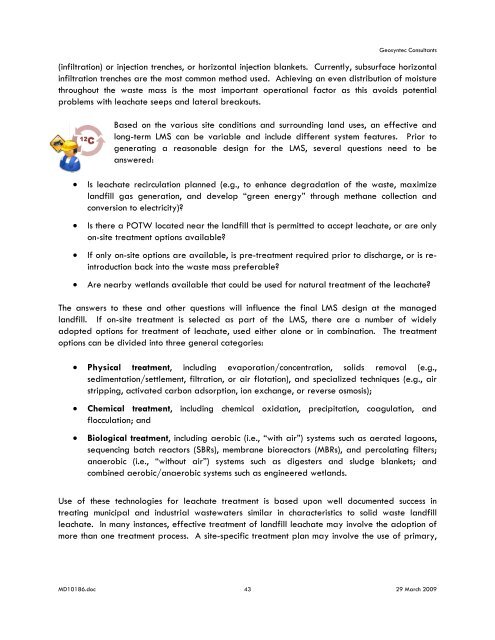AREA A/B ENGINEERING REPORT - Waste Management
AREA A/B ENGINEERING REPORT - Waste Management
AREA A/B ENGINEERING REPORT - Waste Management
You also want an ePaper? Increase the reach of your titles
YUMPU automatically turns print PDFs into web optimized ePapers that Google loves.
Geosyntec Consultants<br />
(infiltration) or injection trenches, or horizontal injection blankets. Currently, subsurface horizontal<br />
infiltration trenches are the most common method used. Achieving an even distribution of moisture<br />
throughout the waste mass is the most important operational factor as this avoids potential<br />
problems with leachate seeps and lateral breakouts.<br />
Based on the various site conditions and surrounding land uses, an effective and<br />
long-term LMS can be variable and include different system features. Prior to<br />
generating a reasonable design for the LMS, several questions need to be<br />
answered:<br />
• Is leachate recirculation planned (e.g., to enhance degradation of the waste, maximize<br />
landfill gas generation, and develop “green energy” through methane collection and<br />
conversion to electricity)?<br />
• Is there a POTW located near the landfill that is permitted to accept leachate, or are only<br />
on-site treatment options available?<br />
• If only on-site options are available, is pre-treatment required prior to discharge, or is reintroduction<br />
back into the waste mass preferable?<br />
• Are nearby wetlands available that could be used for natural treatment of the leachate?<br />
The answers to these and other questions will influence the final LMS design at the managed<br />
landfill. If on-site treatment is selected as part of the LMS, there are a number of widely<br />
adopted options for treatment of leachate, used either alone or in combination. The treatment<br />
options can be divided into three general categories:<br />
• Physical treatment, including evaporation/concentration, solids removal (e.g.,<br />
sedimentation/settlement, filtration, or air flotation), and specialized techniques (e.g., air<br />
stripping, activated carbon adsorption, ion exchange, or reverse osmosis);<br />
• Chemical treatment, including chemical oxidation, precipitation, coagulation, and<br />
flocculation; and<br />
• Biological treatment, including aerobic (i.e., “with air”) systems such as aerated lagoons,<br />
sequencing batch reactors (SBRs), membrane bioreactors (MBRs), and percolating filters;<br />
anaerobic (i.e., “without air”) systems such as digesters and sludge blankets; and<br />
combined aerobic/anaerobic systems such as engineered wetlands.<br />
Use of these technologies for leachate treatment is based upon well documented success in<br />
treating municipal and industrial wastewaters similar in characteristics to solid waste landfill<br />
leachate. In many instances, effective treatment of landfill leachate may involve the adoption of<br />
more than one treatment process. A site-specific treatment plan may involve the use of primary,<br />
MD10186.doc 43 29 March 2009

















